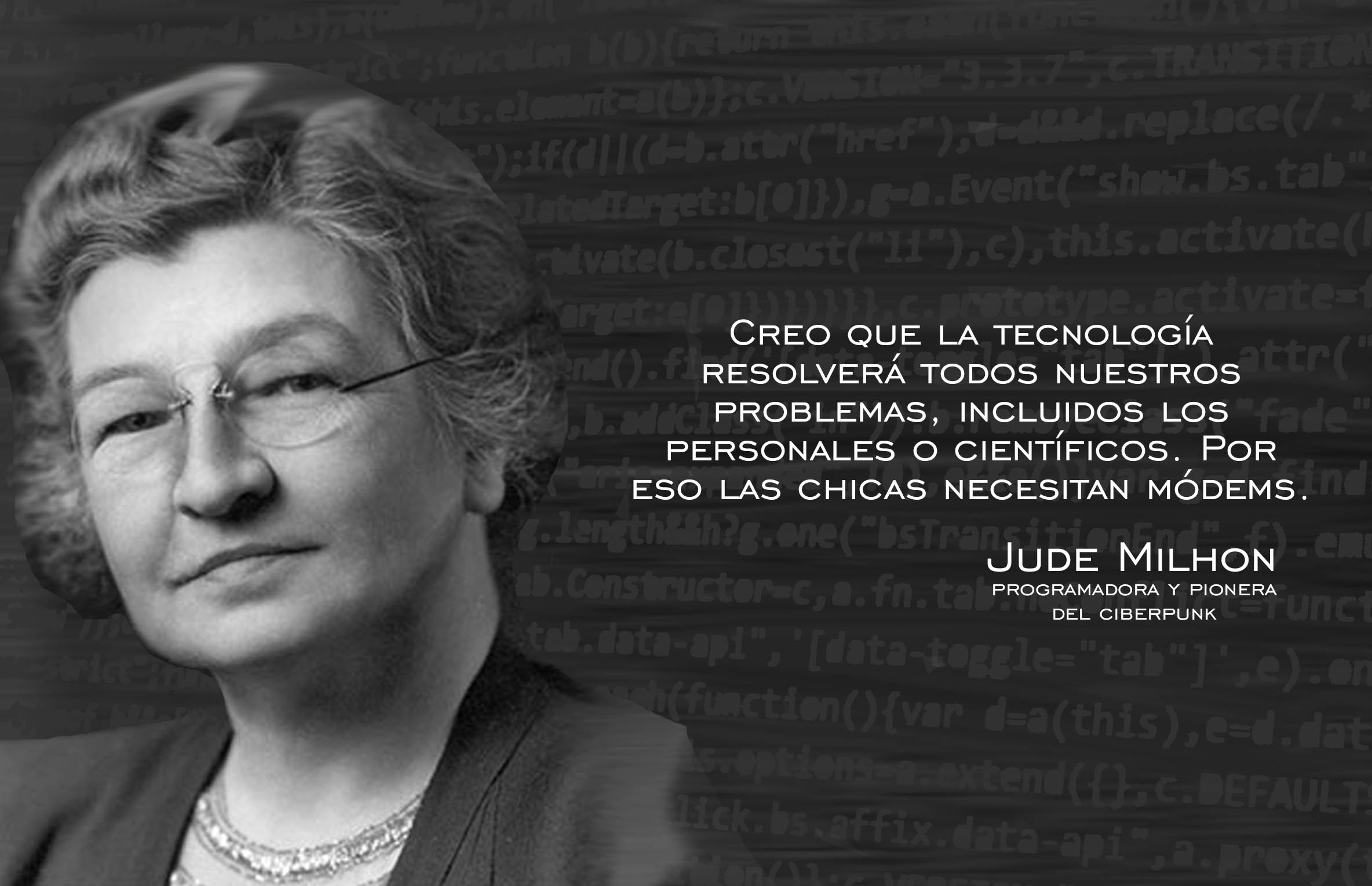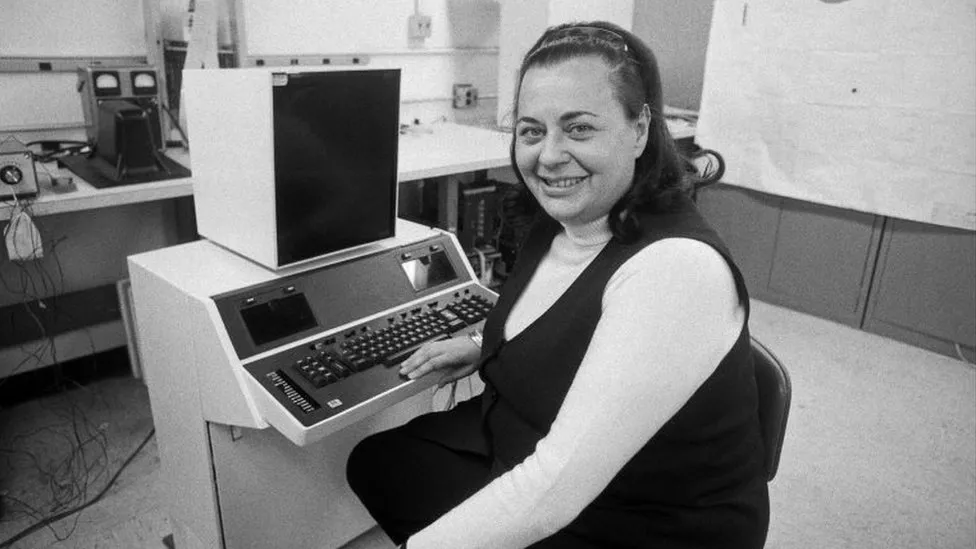Jude Milhon is without a doubt one of the women who have left her mark on the history of computing around the world. She was a myth in life, to the point of being known as “St. Jude, the patron saint of hackers.”
Personal life
He was born in Washington D.C on March 12, 1939, into a military family in the Marine Corps. He grew up in Anderson, Indiana, where he was active in the Civil Rights Movement of the 1960s by helping to organize the march from Selma to Montgomery, Alabama. She was imprisoned for civil disobedience in Jackson, Mississippi.

Jude Milhon married Robert Behling in 1961 and had a daughter, Tresca Behling, with him. Attracted by the growing countercultural movement, Milhon moved near Antioch College in Yellow Springs, Ohio, and established a longhouse with her husband, her young daughter, and her friends.
Professional life of Jude Milhon
In 1967, Milhon began her first steps as a programmer, learning to program in the Fortran language on her own after reading the book “Teach Yourself Fortran”. At that time, Ella Milhon was one of the few women with programming knowledge. The first time she applied her knowledge was programming vending machines while working at Horn & Hardart.
In 1968 she moved to San Francisco with her friend and partner Efrem Lipkin and divorced her husband in 1970.
Once she started in the world of computing, she realized that it was very secretive; directed by military and academic centers. Given this, Milhon began organizing, together with Lee Felsenstein, Efrem Lipkin, Ken Colstad, and Mark Szpakowski, the world’s first digital community, Community Memory.
Community Memory became the first public computerized bulletin board system in 1973. This would later become an unprecedented digital information sharing system for the entire community of users who accessed it.

When the first BSD systems came out in 1977, Milhon was one of the leading coders in its community development. Milhon’s work at Community Memory offered him the skills necessary to program for BSD.
In 1982, Jude Milhon joined the Computer Professionals for Social Responsibility – CPSR. There he played an important role as an activist, defending the opening of knowledge of computing and cyberspace networks. There he worked on the Privaterra and CFP projects.
Writings of Jude Milhon
In the 1990s, Milhon realized that the Internet was an early reality, with many possibilities. In order to help exploit it to the fullest, he dedicated himself to writing, signing his works with the alias “St. Jude”, the same nickname by which she was known in the hacker community.
At that time Milhon coined the term cypherpunk, to name the movement that brought together defenders of digital privacy. The concept of cypherpunk was a play on words that Milhon invented by mixing the cyberpunk concept (which she adored so much) and the ‘cipher’ concept (encryption key). This movement planted the seed for the Tor project for anonymous browsing, the use of PGP for emails, and eventually blockchain and bitcoins.

Activism within the cyber community was also important to Jude. He often urged women to access the Internet because he believed that “when you are in cyberspace, no one knows what your sex is.” The creation of cypherpunks was also part of his policy: privacy goals through encryption. Jude Milhon was one of the first women to become known in the world of cyberspace.
In 1994, she published one of her first books, Hacking the Wetware: The NerdGirl’s Pillow Book. She was a guide who sought to transform women into happy hackers by demystifying the functioning of the body and brain.
“This book uses sexual themes to seduce you, while subtly preparing you to think like a hacker. “You think, therefore you hack… it is a guide to personal transformation”
Jude Milhon
In 1995, he published the book Cyberpunk Handbook: The Real Cyberpunk Fakebook, an authentic fake guide for cyberpunks, written with humor, irony, and a closeness and depth that transcends previous works on this genre. That same year, in an interview conducted by Wired, Milhon would say one of the phrases that would most clearly define his thinking:
“Girls need modems”.
In addition, Jude left us words like “Sticks and stones may break my bones, but words on a screen get at me only as much as I allow them to.” (Sticks and stones may break my bones, but words on a screen affect me to the extent I allow them to.)
St. Jude compared defense against any online attack to martial arts. “ Cyberspace is the best training ground for women,” he said, where physical strength doesn’t matter, and the keyboard is better than a Glock 45.
In 1997, he published How to Mutate & Take Over the World: an Exploded Post-Novel. He writes this book together with RUSirius (with whom he also wrote Cyberpunk Handbook) and as in the previous one, the irony and humor are perceived from the synopsis and the prologue.
Together with Sirius (pseudonym of Ken Goffman) he founded and edited the technological and anarchic culture magazine Mondo 2000.
Mondo 2000 was a cyberculture magazine published in California during the 1980s and 1990s. It covered cyberpunk topics such as virtual reality and smart drugs. It was seen as a more subversive or anarchic reflection than its later contemporary, Wired magazine.
During this time, Milhon would also become an expert web programmer.
In the late 1990s, she worked as a web designer and Internet consultant.
Definition of hacking by Jude Milhon
“Hacking is intelligently evading the limits imposed, whether imposed by your government, by your own abilities or by the laws of physics”
Another of his phrases related to women says:
“Maybe women are not ideal for physical fighting, but we certainly excel at typing like crazy”

During the last years of his life, Jude Milhon dedicated himself to protecting privacy and promoting hacking in the world. To this end he maintained Mondo 2000 magazine until its end in 1998 and also participated in Boing Boing and Wired magazine.
She died on July 19, 2003, a victim of breast cancer. At the time of his death, he was survived by a son, Tresca Behling, and grandson, Emilio Zuniga, as well as his partner of more than 40 years, Efrem Lipkin.
His departure caused a deep response from the hacker community around the world.
After his death, Wired dedicated the following title in its magazine: “Hackers have lost their protective saint”, an article that we invite you to read.
Without a doubt, an exceptional and unmatched woman, a fighter for gender rights and equality, as well as the privacy of our information on the networks.
If you liked the article and found it interesting, remember to share it on your social networks and give it a like.
Bibliography
- St. Jude, Hack Story
- Milhon, Jude, Glossary of Computer Terminology
- Wikipedia (Spanish and English)
- International Women’s Day, tribute to the Holy Protector of Hackers, CIO Latin America
- Jude Milhon, veteran hacker and feminist, has died, Xombra, July 18, 2003







